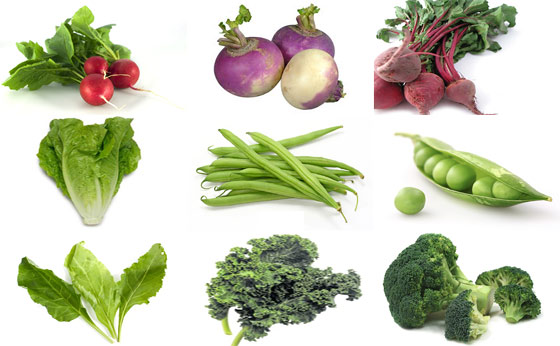Fast Growing Vegetables For Quick Veggie Garden Results

I love to get an early harvest. It’s so good to enjoy the wonderful flavor from the fruits of your labor, so to speak. Whether you’re simply impatient, or just want some of your veggies early — here are some of the fast growing vegetables for your garden.
Fast vegetable crops are good to grow because they provide some food on the table in the shortest period of time. They are a good jump-start to the growing season.
If you have a shorter growing season (colder climate zones), then you can help maximize your garden’s output by growing fast-growing vegetables.
List Of Some Fast Growing Vegetables
These vegetables will provide quick food from the garden…
Radishes
Days to harvest: 20-30. Talk about instant gratification! Radishes are definitely a fast growing vegetable! They might be a little spicy-hot, but they are one of the fastest-growing root vegetables. They’re one of just a few vegetables that you can plant from seed, and harvest them within a month.
Tip: Someone on the blog once said, “Try throwing a few radishes into your vegetable soup. They lose the heat and develop a sweet broccoli like flavor. They are In same family, after all.”
Radish seeds germinate quickly, in just several days (~ 3 or 4). You can keep it going all season by planting weekly. Depending on the variety, radish spacing can range from 1-3 inches.
You might also consider, when sowing radish seeds, plant some about a half-inch deep and the rest a little deeper. Those close to the surface will germinate more quickly, extending the harvest by a few days. The deeper roots will be later, but larger, than the shallow ones.
Turnips
Days to harvest: 30 – 60. (Depending on how big you let them get). Turnips are a fast growing vegetable. The entire plant is edible.
“Turnips are on the top of my list. I call them a “poor mans potato”, since they can be fried, stewed , and even mashed, You can grow three crops a year of these and they even like cool weather.”
commenter on Modern Survival Blog
Plant turnips in rich, loose soil with lots of organic matter and compost. Thin successful seedlings from 4 to 6 inches apart. Mulch heavily and water at a rate of 1 inch per week to prevent the roots from becoming tough and bitter.
Fully mature turnip roots are generally ready after 60 days, when they measure up to 3 inches in diameter – although can be harvested smaller.
Beets
Days to harvest: 35 – 60. Like turnips, the entire plant is edible. In fact beet greens have the most potassium of any vegetable, even more than spinach! Not everyone likest them, but in my opinion, beets are delicious. And sweet tasting.
Beets are a cool season vegetable and do not like heat. They can survive frost and almost freezing temperatures. Consequently, this makes them ideal for northern gardeners.
Thin the young plants to 3 to 4 inches apart once the greens get to be about 4 inches tall. This allows their roots to grow to their proper size. Pick beets when their shoulders protrude from the soil.
Beet roots can be harvested from the time they’re about the size of a golf ball to the size of a tennis ball. Be aware that larger beet roots may be tough and woody.
Spinach
Days to harvest: 30-50. (Depending on how long you let the leaves grow out). Spinach is one of the fastest growing leaf vegetables.
Plant in the spring and start harvesting the leaves within 30 days. A final spacing of 3-5 inches is best for most varieties. So either transplant them directly to this spacing or thin them.
Pick the outer leaves regularly. If you don’t, the leaves become bitter once the plant reaches maturity.
Re-sow seeds every couple of weeks for successive harvests. Spinach will keep growing and producing new leaves all season long.
Zucchini
Days to harvest: 45 – 90. Zucchini is a fast growing vegetable in that you can harvest on the early side. In my opinion, young zucchini tastes better anyway. You can also let them grow longer and they will probably turn into a monster size! A 10 pounder anyone?
Space zucchini plants 18-24″ apart in rows 6′ apart. Wider spacing may allow for easier harvesting.
I love cooking sliced zucchini on the grill after having sprinkled them with a good dose of McCormick Grill Mates Roasted Garlic & Herb! (view on amzn)
Or here’s another idea… Spiralized zucchini — a sort of pasta replacement (Keto friendly).
Bush (Snap) Beans
Days to harvest: 50-70. Bush beans provide a fast and high yield. In about six weeks after planting, you can start harvesting thin, tender bush beans from your garden. To keep the plants productive, harvest when the beans are small.
Snap beans (bush and pole varieties) are best harvested young and tender. You eat them pod and all. They will be tougher if left on the plant too long.
Bush beans are determinate — meaning they grow to a certain size (up to ~ 2 feet tall). They will come to harvest all at once. A good choice if you want your crop to be ready all at once for canning or freezing.
Pole beans are indeterminate — meaning they continue growing through the season. They do require support as they vine. But will continue to produce throughout the season.
Note: Days to harvest are from seed, and will vary depending on your variety and conditions.
What about your experiences with fast growing vegetables? Which ones?
[ Read: Potatoes In Your Garden — Good Choice For Survival Food ]
